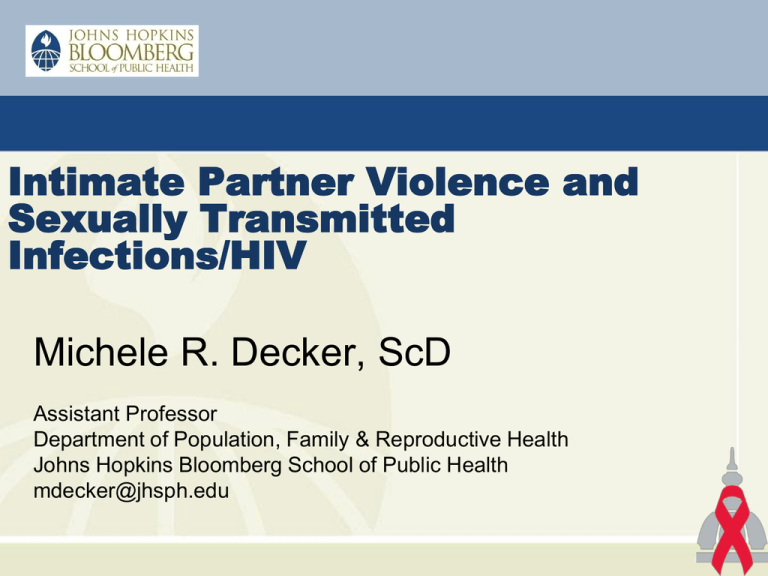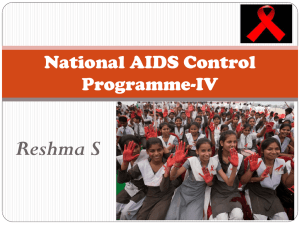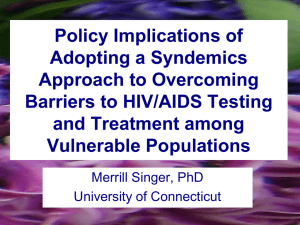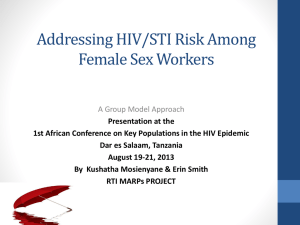
Intimate Partner Violence and
Sexually Transmitted
Infections/HIV
Michele R. Decker, ScD
Assistant Professor
Department of Population, Family & Reproductive Health
Johns Hopkins Bloomberg School of Public Health
mdecker@jhsph.edu
IPV and HIV: Overview
• HIV and other sexually transmitted infections (STIs) in
the US
• How does IPV create risk for HIV and other STIs?
• Violence, HIV and the sex industry: what do violence
providers need to know?
• How can advocates support women at risk and
infected?
HIV and STI among women in the US
• HIV among women and girls
– Women account for 25% of adults living with an HIV diagnosis, and
account for 20% of new HIV infections
– Approximately 300,000 women were living with HIV in 2013
– Young adults ages 25 to 44 account for the majority of new HIV
infections among women
• Women and girls are also vulnerable to sexually transmitted
infections (STIs)
– Chlamydia, gonorrhea, syphilis, hepatitis B, trichomoniasis, HSV 2,
HPV
– 60 million women affected by new and existing STIs in 2013
CDC, 2010; 2013
IPV and HIV among US Women
ORAdj. 3.44 (1.28, 9.22)
(Sareen et al., 2009)
IPV & HIV among Indian women: DHS
ORAdj. 3.92 (1.41, 10.92)
(Silverman, Decker et al., 2008, JAMA)
Dating Violence & STI/HIV: MA YRBS
No violence
10%
9%
Physical and sexual
dating violence
8%
6%
4%
3%
2%
0%
STI/HIV Diagnosis
ORAdj. 2.59 (1.05, 6.35)
(Decker et al., 2005: Pediatrics.)
IPV and STI/HIV
• These graphs illustrate just a few examples of a large
literature linking IPV with STI/HIV risk and infection (e.g.,
Hess et al., 2012; Maman et al, 2000; Gielen et al, 2007; Campbell et al, 2008; Wu
et al, 2003; Sareen et al, 2009)
• Much of the research is cross-sectional, so the
causation is unclear
• In prospective research, IPV is associated with incident
STI, including HIV (Weiss et al., 2008; Allsworth et al., 2009; Jewkes et
al., 2010; Kouyoumdjian et al., 2013)
• More frequent and severe IPV among HIV positive
women (Gielen et al, 2002; McDonnell et al, 2003; Wyatt et al, 2002)
Mechanisms: IPV and STI/HIV
• Compromised sexual negotiation
• inability to refuse sex, or certain kinds of sex
• anal sex increasingly important – 16x transmission efficiency
• Coerced and forced sex
– usually unprotected
– may result in physical trauma and facilitate transmission
• Compromised condom negotiation
• inability to ensure condom use, perpetrator condom refusal
and condom removal
• Greater risk introduced by male violence perpetrators
• engage in greater sexual risk behavior, more likely infected
Perpetrator Condom Refusal
Leading to STD
“I told him to put a condom on, he didn't. ..I went to a
clinic, and they were like, "Oh, he gave you
Chlamydia." [H]e said it was me messin' around with
some other guy, and that's not true, 'cause I was like,
"You were the only guy I was with." And he's like, "Oh,
that's you, you're messin' around," he's like, “fuck you,
I thought you loved me."
Miller, Silverman, Decker et al., qualitative interviews
Perpetrator Condom Refusal
Leading to Pregnancy and STD
“ He would never listen. … I’m like, don’t you think
you should wear condoms you know I might get
pregnant. And he’s like, next time. I’m scared of him.
I’m really scared. Like I feel like he’s going to hurt me.
I feel it. You just, I don’t know. Just like he’s going to
hurt me.”
Miller, Silverman, Decker et al., qualitative interviews
Recent IPV and coercive
sexual/condom dynamics
45%
40%
35%
30%
25%
IPV
20%
No IPV
15%
10%
5%
0%
Condom nonuse against
her will
ORAdj. 1.97
(1.61, 2.42)
Fear of asking for
condom
Afraid to refuse sex
ORAdj 4.36
(2.91, 6.52)
ORAdj 11.39
(7.15, 18.16)
Decker et al., 2013; n=3539 women in family planning clinics
Anal Intercourse and HIV
• Anal intercourse: an underappreciated HIV risk factor
• Unprotected anal intercourse is a highly efficient means of
HIV transmission
– ~16 fold greater risk relative to vaginal intercourse
• IPV linked with anal intercourse, often unprotected (Silverman et
al., 2011; Stockman et al., 2012; Hess et al.; Decker et al.2013,)
• Abrasions and lacerations that accompany unwanted sex
can facilitate transmission.
Recent IPV and recent anal sex
20%
18%
16%
14%
12%
IPV
10%
No IPV
8%
6%
4%
2%
0%
Anal sex
ORAdj 2.13 (1.46, 5.10)
Unprotected anal
ORAdj 2.26 (1.53, 3.33)
Perpetrator STI/HIV Risk
• Male perpetrators of abuse engage in greater risk
behavior
– Sexual infidelity/concurrent partnerships
– Injection drug use
– Anal intercourse
– Coercive condom nonuse
– Sex with high risk partners (female sex workers)
• Abuse perpetrators are more likely to be infected!
(Decker et al., 2009, Silverman et al., 2007; Dunkle et al., 2006)
IPV Perpetration & Husband’s HIV:
Husband-wife Dyads in India
0.8%
non perpetrators
IPV perpetrators
0.6%
0.6%
0.4%
0.3%
0.2%
0.0%
HIV
OR*adj 1.90 (1.11, 3.26)
Decker et al., 2009
How does IPV relate to HIV?
• Women victimized by IPV face “double jeopardy”
– High risk male partner more likely to be infected
• IPV as a risk marker for an infected male partner
– Limited control over sex and other aspects of violent
relationships may facilitate transmission
• IPV as a risk factor for transmission in the presence of men’s
infection
• IPV may enhance or facilitate transmission
Violence and STI/HIV disclosure
• STI/HIV disclosure can be a trigger or context for
abuse (Gielen et al, 2000; Zierler et al, 2000; Zoenig et al, 2002; Medly et al,
2004; Maman et al, 2002; Kiarie et al, 2006)
• Fear of IPV could be barrier for HIV-positive
women to seek health care (Lichtenstein, 2005)
• Need to prioritize safety!
IPV and Fear of Partner STI Notification
RRadj 1.46 (1.20, 1.77)
Decker et al., 2011
IPV and Partner Response to STI
Notification
Among those with STI history & who notified partners:
Decker et al., 2011
Violence and sex trade
• IPV and other forms of violence are common among
women involved in sex trade, including sexual
exploitation, and economically motivated sex
– Abusive partners can pressure women into sex trade as a
means of control or obtaining scarce resources
– Sex trade as a means of escaping abusive relationships
– Pimp relationships can begin as, and be presented as,
romantic relationships
A brief history:
Women in Sex Work
often known as Female Sex Workers (FSWs)
• Consistently demonstrate high rates of HIV and other
STDs
– ~11 times that of women of reproductive age (Baral et al., 2012)
• Historically regarded as a vector for disease transmission
• Recent recognition of gender-based vulnerabilities within
this context
– Trafficking
– Violence victimization
– Coercion and limitations on power to negotiate sex and
condom use
What’s in a name?
transactional sex SEX TRADE commercial sex work
prostitution commercial sexual exploitation survival sex
SEX WORK
SEX TRAFFICKING
• Common: exchange of sex for drugs, money or other
resources
• Distinct: [assumed] degrees of agency, exploitation, control
• Realities:
• assumptions have not been well tested
• many that trade sex do not identify as sex workers
• little is known about agency e.g., conditions of entry, ability to exit
What does this mean for advocates?
• Sex trade a context for intense HIV risk
• Be sensitive and aware of the possibility that IPV can
co-occur with sex trade or sexual exploitation for your
clients
• Establish relationships with programs in your area that
work with women in sex work and/or sexual exploitation
• Anticipate unique dimensions of shame and trauma for
women involved in sex trade
IPV & HIV:
Implications for Violence Providers
• Raise awareness about links between IPV and STI/HIV
– Remind your clients that abusers engage in greater risk behavior
– Ask them if they have been tested and support them in doing so
• Leverage these data to generate discussion about sexual
negotiation, condom negotiation, anal sex
• Frame within safety, health
Raise the issue of sexual violence and
coercion
• Give clients an opportunity to raise these issues
• Affirm that their experiences are
• Normalizing probes
– Sexual decision-making
• How much do you feel you can refuse sex?
– Condom coercion
• What does condom negotiation look like? How much do you
feel that you have a say in protection?
– Anal intercourse
• We are hearing so much about violence and unwanted anal
sex we are starting to ask about it.
What can I do to support STI/HIV
testing?
• Assure access to STI/HIV testing for clients!
• Make connections with your local STI/HIV providers
– Find out how sensitive your local STD/HIV testing clinics
are to issues of violence
– Make sure you feel confident referring patients, or provide
in-person advocacy
• Need an STI/HIV testing site in your area?
– http://hivtest.cdc.gov
Supporting safety in testing
• The best defense is preparation
– Safety planning with women for potential STI/HIV
diagnosis
– Become familiar with the STI/HIV partner notification
protocols in your area
• Anonymous notification, or clinic-facilitated notification, can
enhance safety
• Enable safety through
– Anonymous disclosure
• www.sotheycanknow.org
– Clinician or advocate supported referral
– Safety planning specific to disclosure
Postexposure Prophylaxis (PEP)
• PEP is an antiretroviral therapy regimen that can reduce risk
for HIV after potential exposure
– Should be used within 72 hours of exposure
– Should not be used by people with frequently recurring
exposure
– Part of standard options for sexual assault survivors; less
applicable for women experiencing chronic abuse
• Can be covered by insurance or accessed through the
Office for Victims of Crime
Supporting HIV+ Women
• Help to prevent violence and abuse
• Provide a safe and supportive environment for
disclosure
• Consider issues with medication adherence and
access to medical services
• Use universal precautions to reduce stigma
• Be aware of other associated issues
• Create a service support network
Violence and HIV status
disclosure
• Violence can result from disclosure of HIV status
• Abusers can use women’s HIV status as a tactic of
abuse and coercion
– Threaten to reveal HIV status to family, friends,
employer
– Threaten to use HIV status to influence parental custody
decisions
– Humiliate or degrade her for being HIV positive
– Using her HIV status as an excuse for violence or abuse
Providing a safe and supportive
environment for HIV+ women
• Assure confidentiality
• Use non-stigmatizing and non-judgmental language and
actions
• YOU are an important part of changing the culture that
stigmatizes HIV+ women!
– Talk about HIV just the way you would anything else
– Remind your staff and other clients that HIV is not transmitted
through skin-to-skin contact
– Demonstrate that you are not afraid of becoming infected!
Violence and access to HIV care
• IPV can be a barrier for HIV-positive women to access
health care
• Fear of IPV as a result of disclosure can prevent women
from seeking care
• Abusive partners can prevent women from accessing
care through
– Threats of violence
– Isolation
– Stalking
IPV and interference in medication
adherence
• HIV medication regimens can be complex and adherence is
critical
• Consistent medication adherence can be a challenge for
women in violent relationships
– Medication interference by partners
– Difficulty with consistently taking medication given competing
priorities
– PTSD and depression is associated with low medication
adherence
Bringing it all together:
IPV & STI/HIV
• Raise awareness of the links of IPV with STI/HIV
• Initiate discussion with clients about the STI/HIV risks
that can accompany IPV
• Be prepared to discuss coercive aspects of sexual and
condom negotiation
• Assure access to STI/HIV testing for clients
• Make connections with your local STI/HIV providers
• Know where STI/HIV testing sites are in your area
• Be aware of the safety issues surrounding disclosure
Further Reading/Resources
Campbell, J. C., Baty, M. L., Ghandour, R. M., Stockman, J. K., Francisco, L., & Wagman, J. The
intersection of intimate partner violence against women and HIV/AIDS: a review. International
journal of injury control and safety promotion, 2008;15(4), 221-231
Decker MR, Seage GR, Hemenway D, Gupta J, Raj A, Silverman JG. Intimate partner violence
perpetration, standard and gendered STI/HIV risk behaviour, and STI/HIV diagnosis among a clinicbased sample of men. Sexually transmitted infections. Dec 2009;85(7):555-560.
Decker MR, Seage GR, 3rd, Hemenway D, et al. Intimate partner violence functions as both a risk marker
and risk factor for women's HIV infection: findings from Indian husband-wife dyads. Journal of
acquired immune deficiency syndromes. Aug 15 2009;51(5):593-600.
Decker MR, Wirtz AL, Baral SD, et al. Injection drug use, sexual risk, violence and STI/HIV among
Moscow female sex workers. Sexually transmitted infections. Jun 2012;88(4):278-283.
Dunkle KL, Decker MR. Gender-Based Violence and HIV: Reviewing the Evidence for Links and Causal
Pathways in the General Population and High-risk Groups. American journal of reproductive
immunology. Feb 2013;69 Suppl 1:20-26.
Dunkle KL, Jewkes RK, Nduna M, et al. Perpetration of partner violence and HIV risk behaviour among
young men in the rural Eastern Cape, South Africa. Aids. Oct 24 2006;20(16):2107-2114.
Gielen, A. C., Ghandour, R. M., Burke, J. G., Mahoney, P., McDonnell, K. A., & O'Campo, P. HIV/AIDS
and intimate partner violence: Intersecting women's health issues in the United States. Trauma,
Violence, and Abuse, 2007; 8(2), 178-198.
Hess KL, Javanbakht M, Brown JM, Weiss RE, Hsu P, Gorbach PM. Intimate partner violence and
sexually transmitted infections among young adult women. Sexually transmitted diseases. May
2012;39(5):366-371.
Further Reading/Resources
Illangasekare, S.L., Tello, M., Hutton, H., Moore, R., Anderson, J., Baron, J., Chander, G. Clinical and
mental health correlates and risk factors for intimate partner violence among HIV-positive
women in an inner city HIV clinic. Women’s Health Issues, 2012; 22(6), e563-e569.
Jewkes R, Sikweyiya Y, Morrell R, Dunkle K. The relationship between intimate partner violence, rape
and HIV amongst South African men: a cross-sectional study. PloS one. 2011;6(9):e24256.
Jewkes RK, Dunkle K, Nduna M, Shai N. Intimate partner violence, relationship power inequity, and
incidence of HIV infection in young women in South Africa: a cohort study. Lancet. Jul 3
2010;376(9734):41-48.
Maman S, Campbell J, Sweat MD, Gielen AC. The intersections of HIV and violence: directions for
future research and interventions. Social science & medicine. Feb 2000;50(4):459-478.
Raj A, Reed E, Miller E, Decker MR, Rothman EF, Silverman JG. Contexts of condom use and noncondom use among young adolescent male perpetrators of dating violence. AIDS care. Sep
2007;19(8):970-973.
Sexual Violence and HIV special issue: http://onlinelibrary.wiley.com/doi/10.1111/aji.2013.69.issues1/issuetoc
Silverman JG, Decker MR, Kapur NA, Gupta J, Raj A. Violence against wives, sexual risk and sexually
transmitted infection among Bangladeshi men. Sexually transmitted infections. Jun
2007;83(3):211-215.
Weiss HA, Patel V, West B, Peeling RW, Kirkwood BR, Mabey D. Spousal sexual violence and
poverty are risk factors for sexually transmitted infections in women: a longitudinal study of
women in Goa, India. Sexually transmitted infections. Apr 2008;84(2):133-139.





